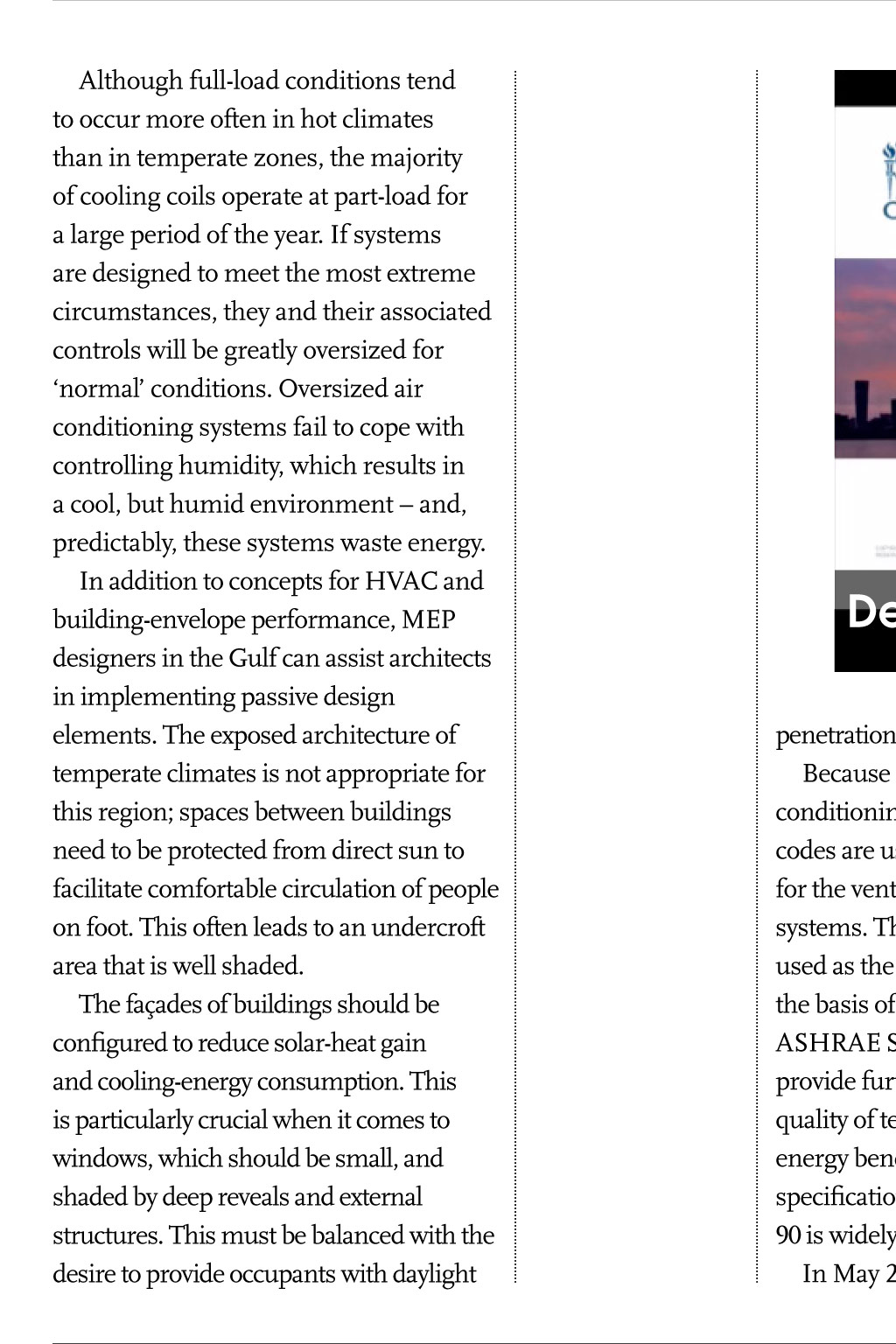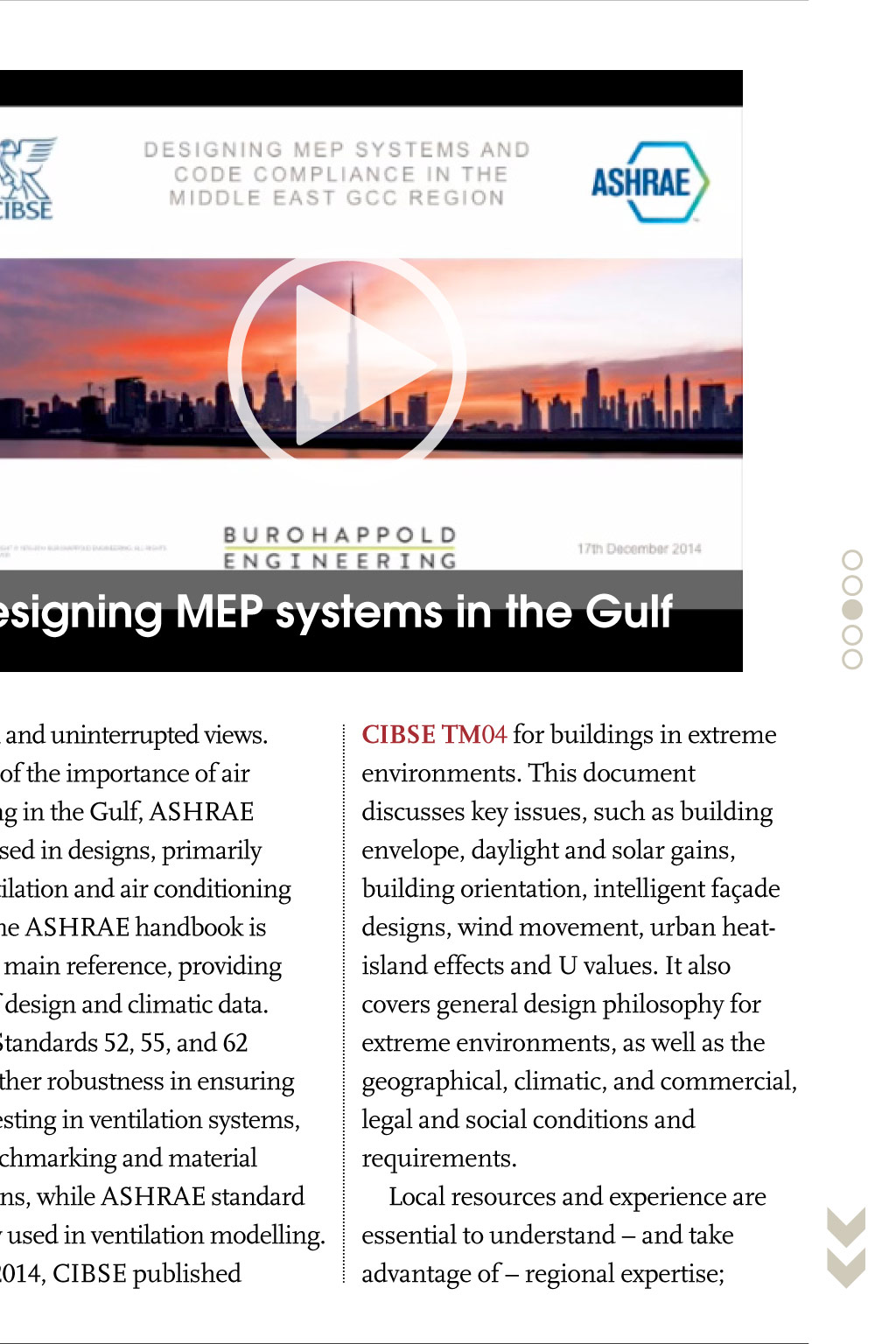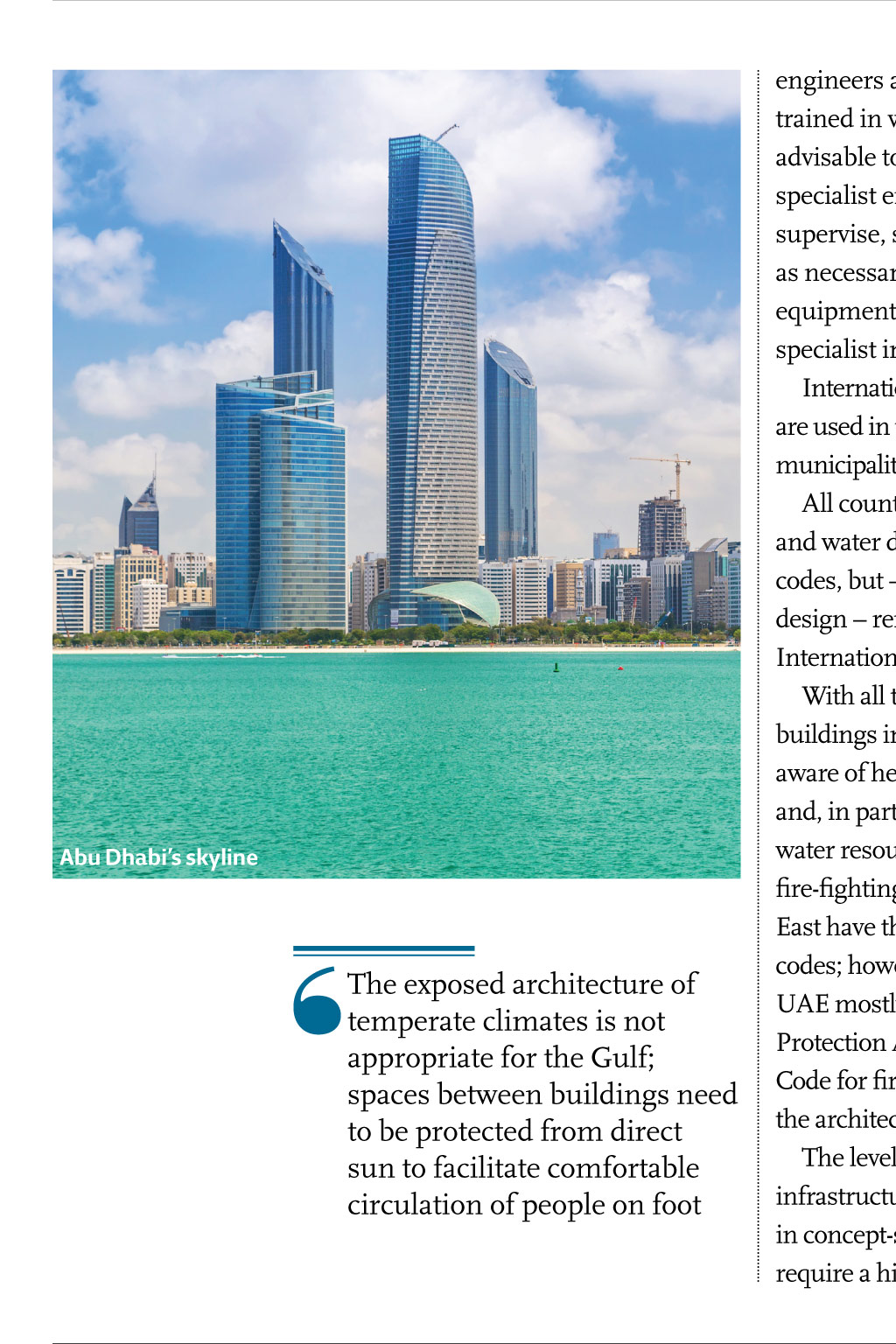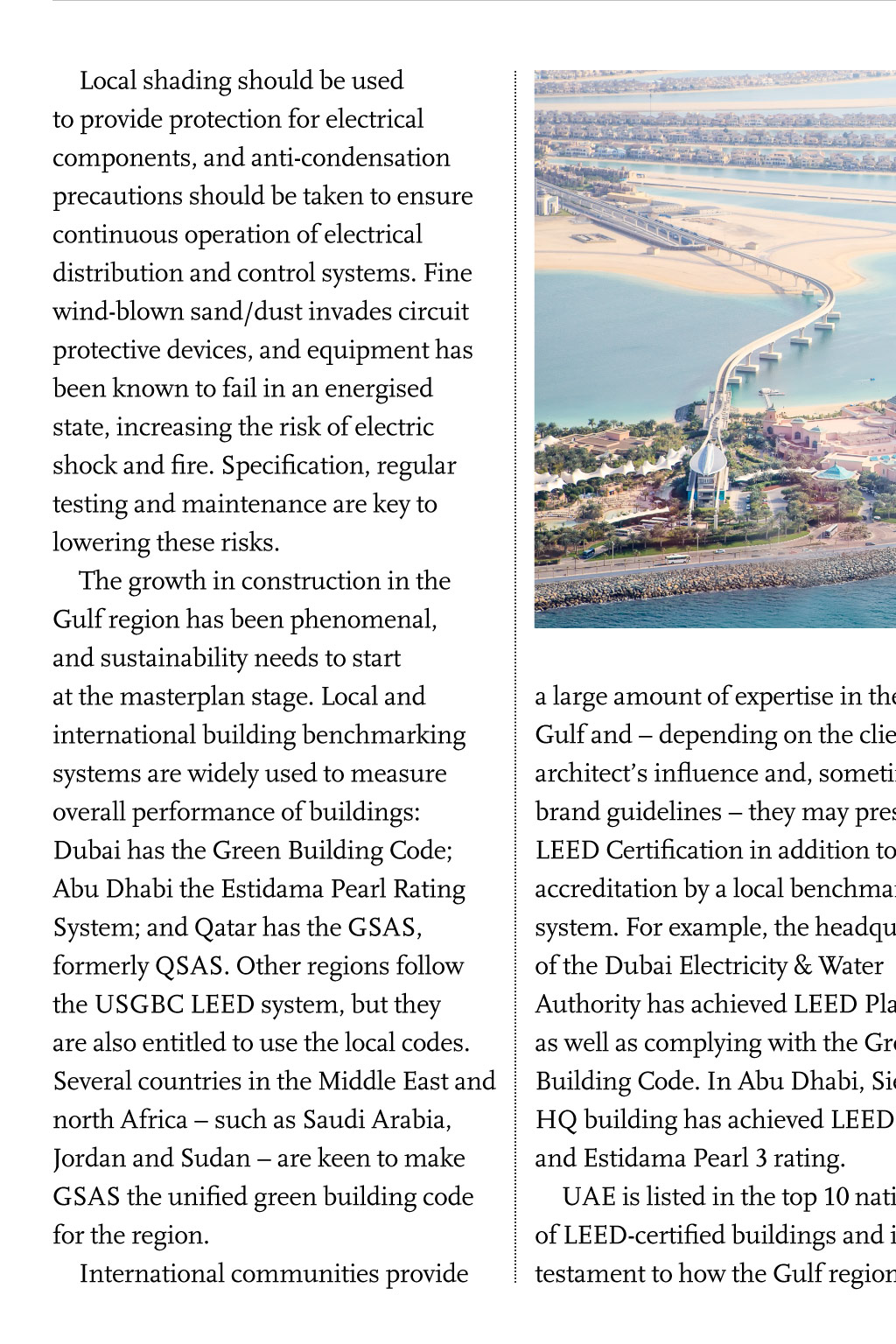




















Gulf States Design Codes Mep Designers Face Myriad Sustainability Challenges When Working In The Gulf, But As Chewpieng Ryan and Catherine Elliott-Scott explain what seems like a negative can be transformed into a positive TUrnInG THE deseRt GReen T he Gulf Cooperation Countries (GCC) have embarked upon ambitious expansion and economic diversification plans in recent years. These have involved huge amounts of government spending across the industrial, energy and infrastructure sectors, as well as the construction of houses, sanitation and education facilities to upgrade standards of living while achieving sustainable economic growth. All of this is being done in highly challenging climatic conditions. The biggest challenge facing mechanical, electrical and public health (MEP) designers in this region is the extreme environment, which drives the conceptual designs for building services systems and, thereafter, the processes that ensure the quality of the concepts is maintained. The entire GCC region is desert, according to the climate classification of Kppen-Geiger. The majority falls into the hot desert category and only a small area in the north-west of Saudi Arabia into the cold desert classification. A hot desert climate is characterised by extreme heat which regularly rises above 45C high humidity, and intense UV radiation. Sand erosion, plus Burj Al Arab hotel in Dubai high levels of dust, haze and fog, also contribute to the severe environment. Other notable challenges for building services engineers in the Gulf include: Poor facilities maintenance, post completion The risk of earthquakes The need to protect tall buildings and their contents from lightning strikes Seasonal, dense, early-morning fog, which causes heavy condensation when air conditioning is used Floods caused by very occasional Although full-load conditions tend to occur more often in hot climates than in temperate zones, the majority of cooling coils operate at part-load for a large period of the year. If systems are designed to meet the most extreme circumstances, they and their associated controls will be greatly oversized for normal conditions. Oversized air conditioning systems fail to cope with controlling humidity, which results in a cool, but humid environment and, predictably, these systems waste energy. In addition to concepts for HVAC and building-envelope performance, MEP designers in the Gulf can assist architects in implementing passive design elements. The exposed architecture of temperate climates is not appropriate for this region; spaces between buildings need to be protected from direct sun to facilitate comfortable circulation of people on foot. This often leads to an undercroft area that is well shaded. The faades of buildings should be configured to reduce solar-heat gain and cooling-energy consumption. This is particularly crucial when it comes to windows, which should be small, and shaded by deep reveals and external structures. This must be balanced with the desire to provide occupants with daylight Stringent regulations The thermal performance of the building envelope is one of the main drivers in determining the cooling load and resultant energy use of a construction. It is important, therefore, to consider its design at the outset, as this will be a fundamental driver in determining building services concepts. Insulation, for example, plays an important role in reducing the heat exchange between interior and exterior environments, as well as the formation of condensation. Designing MEP systems in the Gulf penetration and uninterrupted views. Because of the importance of air conditioning in the Gulf, ASHRAE codes are used in designs, primarily for the ventilation and air conditioning systems. The ASHRAE handbook is used as the main reference, providing the basis of design and climatic data. ASHRAE Standards 52, 55, and 62 provide further robustness in ensuring quality of testing in ventilation systems, energy benchmarking and material specifications, while ASHRAE standard 90 is widely used in ventilation modelling. In May 2014, CIBSE published Abu Dhabis skyline The exposed architecture of temperate climates is not appropriate for the Gulf; spaces between buildings need to be protected from direct sun to facilitate comfortable circulation of people on foot Local shading should be used to provide protection for electrical components, and anti-condensation precautions should be taken to ensure continuous operation of electrical distribution and control systems. Fine wind-blown sand/dust invades circuit protective devices, and equipment has been known to fail in an energised state, increasing the risk of electric shock and fire. Specification, regular testing and maintenance are key to lowering these risks. The growth in construction in the Gulf region has been phenomenal, and sustainability needs to start at the masterplan stage. Local and international building benchmarking systems are widely used to measure overall performance of buildings: Dubai has the Green Building Code; Abu Dhabi the Estidama Pearl Rating System; and Qatar has the GSAS, formerly QSAS. Other regions follow the USGBC LEED system, but they are also entitled to use the local codes. Several countries in the Middle East and north Africa such as Saudi Arabia, Jordan and Sudan are keen to make GSAS the unified green building code for the region. International communities provide heavy rainfall with which the drainage systems are not designed to cope. Sandstorms also affect the design of ventilation systems, so special consideration must be given to sandtrap louvres. However, these challenges also present great opportunities. For example, high humidity and fog offer the chance for dew harvesting and water storage in a region where water is scarce. Flooding can also be used to restore the natural valleys and waterways, known as wadi. A good example of this is Wadi Hanifah, in Riyadh, where the natural environment has been restored and enhanced to provide a public space for residents and their families. CIBSE TM04 for buildings in extreme environments. This document discusses key issues, such as building envelope, daylight and solar gains, building orientation, intelligent faade designs, wind movement, urban heatisland effects and U values. It also covers general design philosophy for extreme environments, as well as the geographical, climatic, and commercial, legal and social conditions and requirements. Local resources and experience are essential to understand and take advantage of regional expertise; engineers and technicians here are trained in western technologies. It is advisable to allow the manufacturers specialist engineers or representatives to supervise, set to work and commission, as necessary, while the use of packaged equipment involving minimal need for specialist installations is encouraged. International Plumbing Codes (IPCs) are used in the region, alongside local municipality and utility distribution codes. All countries have their own electric and water distribution company codes, but when it comes to detailed design reference is made to IPCs and International Mechanical Codes. With all the development and tall buildings in the Gulf, the industry is fully aware of health and safety in construction and, in particular given the lack of water resources life safety in relation to fire-fighting. All countries in the Middle East have their own fire and life-safety codes; however, countries such as the UAE mostly refer to the National Fire Protection Association 101 Life Safety Code for fire-fighting design, as well as the architectural life and safety systems. The level of redundancy in electrical infrastructure is a fundamental driver in concept-stage design. Clients often require a higher redundancy than in a European counterpart building for a variety of reasons, including availability, stability and quality of supply. Mechanical cooling is a prerequisite for the safe and comfortable operation of many buildings, and is often generator-backed, with the knock-on impact on space requirements and acoustic considerations associated with this type of plant. In the GCC area, wiring regulations are generally based on IEC 60364 (BS 7671 is used in the UK). However there are local quirks; for example, in Kuwait it is not permitted to consider more than PF > 0.8 in demand calculations, regardless of the PFC equipment installed and additional de-rating factors are required for transformer sizings, which can have a significant impact on the installed infrastructure. Outdoor building services equipment must be dust-proof, to prevent premature failure of switchgear, control gear and machines. ANSI/IEC 605292004 Degrees of Protection Provided by Enclosures (IP Code) (National Electrical Manufacturers Association, 2004) outlines the sealing effectiveness of enclosure of electrical equipment. Using this classification system, external control panels and switchboards should be rated IP53 and IP64. a large amount of expertise in the Gulf and depending on the client, architects influence and, sometimes, brand guidelines they may prescribe LEED Certification in addition to accreditation by a local benchmarking system. For example, the headquarters of the Dubai Electricity & Water Authority has achieved LEED Platinum, as well as complying with the Green Building Code. In Abu Dhabi, Siemens HQ building has achieved LEED Gold and Estidama Pearl 3 rating. UAE is listed in the top 10 nations of LEED-certified buildings and is testament to how the Gulf region is very conscious of the sustainability agenda, as well as the need to design and build quality developments. cJ This article is adapted from a webinar given by the authors for the CIBSE ASHRAE Group. The presentation Designing MEP Systems and Code compliance in the Middle East GCC Region is available on the CIBSE ASHRAE website along with other Group events. CHEwPIENG RYAN MCIBSE is group director, and CATHERINE ELLIOTT-SCOTT MSLL is associate, at Buro Happold